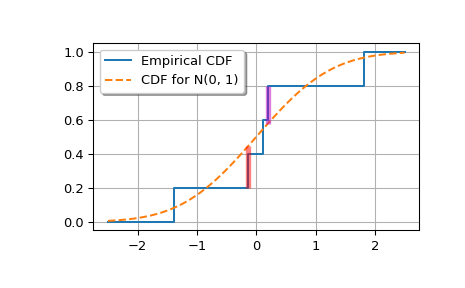scipy.special.smirnov#
- scipy.special.smirnov(n, d, out=None) = <ufunc 'smirnov'>#
Kolmogorov-Smirnov complementary cumulative distribution function
Returns the exact Kolmogorov-Smirnov complementary cumulative distribution function,(aka the Survival Function) of Dn+ (or Dn-) for a one-sided test of equality between an empirical and a theoretical distribution. It is equal to the probability that the maximum difference between a theoretical distribution and an empirical one based on n samples is greater than d.
- Parameters:
- nint
Number of samples
- dfloat array_like
Deviation between the Empirical CDF (ECDF) and the target CDF.
- outndarray, optional
Optional output array for the function results
- Returns:
- scalar or ndarray
The value(s) of smirnov(n, d), Prob(Dn+ >= d) (Also Prob(Dn- >= d))
See also
smirnoviThe Inverse Survival Function for the distribution
scipy.stats.ksoneProvides the functionality as a continuous distribution
kolmogorov,kolmogiFunctions for the two-sided distribution
Notes
smirnovis used by stats.kstest in the application of the Kolmogorov-Smirnov Goodness of Fit test. For historical reasons this function is exposed in scpy.special, but the recommended way to achieve the most accurate CDF/SF/PDF/PPF/ISF computations is to use the stats.ksone distribution.Examples
>>> import numpy as np >>> from scipy.special import smirnov >>> from scipy.stats import norm
Show the probability of a gap at least as big as 0, 0.5 and 1.0 for a sample of size 5.
>>> smirnov(5, [0, 0.5, 1.0]) array([ 1. , 0.056, 0. ])
Compare a sample of size 5 against N(0, 1), the standard normal distribution with mean 0 and standard deviation 1.
x is the sample.
>>> x = np.array([-1.392, -0.135, 0.114, 0.190, 1.82])
>>> target = norm(0, 1) >>> cdfs = target.cdf(x) >>> cdfs array([0.0819612 , 0.44630594, 0.5453811 , 0.57534543, 0.9656205 ])
Construct the empirical CDF and the K-S statistics (Dn+, Dn-, Dn).
>>> n = len(x) >>> ecdfs = np.arange(n+1, dtype=float)/n >>> cols = np.column_stack([x, ecdfs[1:], cdfs, cdfs - ecdfs[:n], ... ecdfs[1:] - cdfs]) >>> with np.printoptions(precision=3): ... print(cols) [[-1.392 0.2 0.082 0.082 0.118] [-0.135 0.4 0.446 0.246 -0.046] [ 0.114 0.6 0.545 0.145 0.055] [ 0.19 0.8 0.575 -0.025 0.225] [ 1.82 1. 0.966 0.166 0.034]] >>> gaps = cols[:, -2:] >>> Dnpm = np.max(gaps, axis=0) >>> print(f'Dn-={Dnpm[0]:f}, Dn+={Dnpm[1]:f}') Dn-=0.246306, Dn+=0.224655 >>> probs = smirnov(n, Dnpm) >>> print(f'For a sample of size {n} drawn from N(0, 1):', ... f' Smirnov n={n}: Prob(Dn- >= {Dnpm[0]:f}) = {probs[0]:.4f}', ... f' Smirnov n={n}: Prob(Dn+ >= {Dnpm[1]:f}) = {probs[1]:.4f}', ... sep='\n') For a sample of size 5 drawn from N(0, 1): Smirnov n=5: Prob(Dn- >= 0.246306) = 0.4711 Smirnov n=5: Prob(Dn+ >= 0.224655) = 0.5245
Plot the empirical CDF and the standard normal CDF.
>>> import matplotlib.pyplot as plt >>> plt.step(np.concatenate(([-2.5], x, [2.5])), ... np.concatenate((ecdfs, [1])), ... where='post', label='Empirical CDF') >>> xx = np.linspace(-2.5, 2.5, 100) >>> plt.plot(xx, target.cdf(xx), '--', label='CDF for N(0, 1)')
Add vertical lines marking Dn+ and Dn-.
>>> iminus, iplus = np.argmax(gaps, axis=0) >>> plt.vlines([x[iminus]], ecdfs[iminus], cdfs[iminus], color='r', ... alpha=0.5, lw=4) >>> plt.vlines([x[iplus]], cdfs[iplus], ecdfs[iplus+1], color='m', ... alpha=0.5, lw=4)
>>> plt.grid(True) >>> plt.legend(framealpha=1, shadow=True) >>> plt.show()
